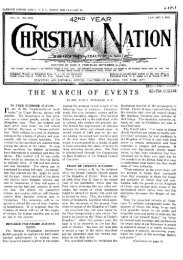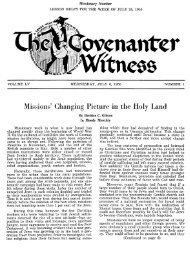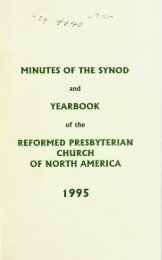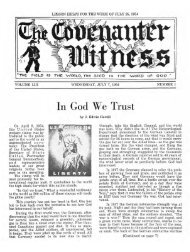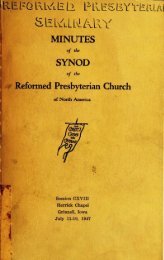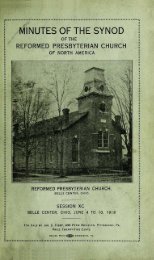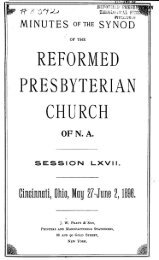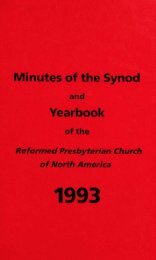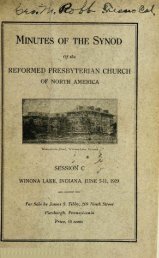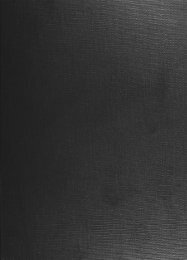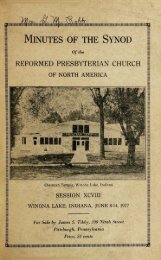Covenanter Witness Vol. 86 - Rparchives.org
Covenanter Witness Vol. 86 - Rparchives.org
Covenanter Witness Vol. 86 - Rparchives.org
Create successful ePaper yourself
Turn your PDF publications into a flip-book with our unique Google optimized e-Paper software.
Finally, nothing can be accomplished without thepower which God provides through the Scriptures, prayer,and actual practice in witnessing. Therefore, through theproper union of value, duty, desire, and power —evangelism is not only possible, but inevitable. This inreality is the will of God which glorifies His Name and inturn increases our enjoyment of Him.After having said so much, in order to make apersonal application of this theme, one must refer to theScriptures. Taking the occasion on which Christ taughtHis disciples to be personal examples for other people,this quotation seems most appropriate:If ye know these things, blessed are ye if ve do them(John 13:17). .. .Bible Reading And PrayerIn The Public SchoolRev. GlenPastor of Santa AnaThis is a subject that most everyone has strongfeelings about, either pro or con.Senators Hugh Scott of Pennsylvania, HowardBaker, Jr., of Tennessee, and Representative John Pastoreof Rhode Island indicated late last year that they wouldintroduce into the 92nd Congress bills on the Bible readingand prayer issue in public schools, similar to the oneintroduced by Senator Everett Dirksen before his death.Consider with me the history of this issue briefly before wedig deeper into the debate raging around the SupremeCourt rulings of the past ten years.Before the Constitutional Convention and the FirstAmendment, the schools which existed in the 13 originalstates taught religion as evidenced by the curricula andtextbooks of the time. This included the established publicschools as well as schools in New England where a statechurch continued until the 1830's. (Dr. Robert Ulich;Harvard Graduate School of Education Assoc. Bulletin,X, Summer 1965 pp. 2-6)The McGuffey Eclectic Readers, which were thedominating core of the U.S. school curriculum for almost100 years, gave further evidence of religion being taught inthe public schools even up until 1925, when 122 million ofthem had been sold and almost universally used. In factMcGuffey was founder of the Ohio public or statecommon school system and found nothing inconsistentwith using his readers which had many references toprayer and God and also encouragements to pray. (TheBasic Everyday Encyclopedia; Random House 1954, p.341)It has only been in the last generation that most ofthe objection has come against the Bible and prayer in theschools for religious use. To be sure the problem graduallyarose earlier through intolerance of the clergy in regard todifferent interpretations of the Gospel, the growingnumber of immigrants of different faiths, including non-Christian faiths, the growth of humanism, of atheism, ofrelativistic philosophies, and of new scientific theoriessuch as Darwinism. (Dr. Robert Ulich; op. cite p. 2-6)In the first of two Supreme Court decisions therecitation of the New York Regents Prayer was declaredunconstitutional in 1962. In the second decision on theMurray-Schempp cases religious prayer and reading of theMARCH 24, 1971n McFarlandCalifornia R. P. ChurchBible, with permission for objectors to be excused fromthese devotional services, was declared unconstitutionalby the court in 1963. In this latter case the door was leftopen for the limited use of the Bible only in the publicschools when not in connection with a religious service ordevotions. The Court said, "The Bible is worthy of studyfor its literary and historic qualities. Nothing we have saidhere indicates that such study of the Bible or religion,when presented objectively as a part of a secular programof education, may not be effected consistent with the FirstAmendment." (Congressional Digest Nov. 1964)Since our subject is not just the devotional orreligious use of the Bible in the public schools, let mereport on some ways that the public schools are implementingthis permitting clause of the 1963 SupremeCourt's Decision. Many teachers and school boards aredevising their own ways and means to do the job.Teaching the Bible as literature has perhaps won morefavor than any other. In Indiana, almost two thirds of thepublic schools use the Bible in their literature classes anda course in Biblical literature is an authorized elective forhigh school students. In Ge<strong>org</strong>ia, too, most teachers wereincluding the Bible as a text in literature courses in 1965.Teachers of history are making similar efforts, suchas in California where public school teachers are requiredto include in their courses appropriate study of the role ofreligion in the story of mankind.Sociology offers another field to study religion's rolein human affairs. In New York schools the sociologyclasses are divided into small discussion groups, withProtestant, Catholic, and Jewish students asked to explaintheir own faiths. (Clarence W. Hall; Reader's Digest,February 1965)More recently the California State Board ofEducation left the door open for the Bible explanation ofcreation to be studied in the science classes of theirelementary schools. The Board did this on the basis thatthe accounts of science in the Bible are every bit asscientific as evidence of evolution, since you have to havefaith to believe either explanation. (National Observer;Jan. 5, 1970; Roy H. Copperud)Though many persons are satisfied with theSupreme Court's Decision, including many church



